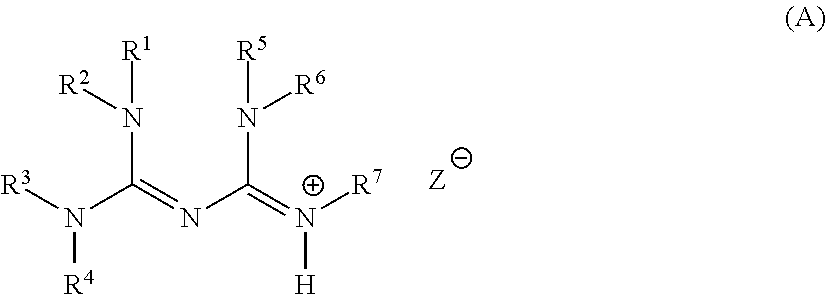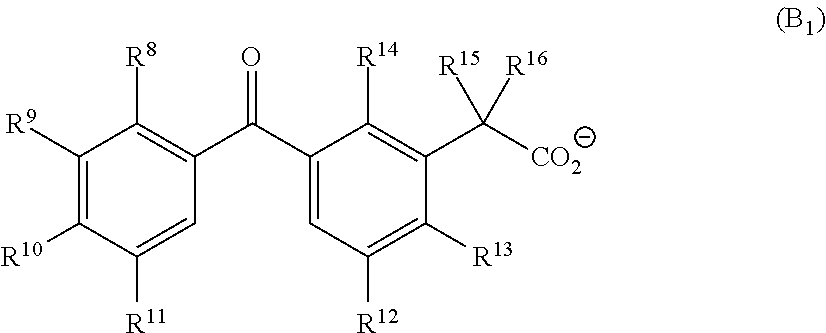Base generator, base-reactive composition containing said base generator, and base generation method
a technology of base generator and reactive composition, which is applied in the field of base generator, can solve the problems of reducing film performance, inhibiting polymerization reaction, suppressing curing, etc., and achieves the effects of low nucleophilicity, high heat resistance, and high solubility
- Summary
- Abstract
- Description
- Claims
- Application Information
AI Technical Summary
Benefits of technology
Problems solved by technology
Method used
Image
Examples
example 1
of 1,2-diisopropyl-1,4,4,5,5-pentamethylbiguanide
[0384]1.00 g of 1,2-diisopropyl-4,4,5,5-tetramethylbiguanide (4.1 mmol; produced by Wako Pure Chemical Industries, Ltd.), obtained in the Synthetic Example 1, and 0.3 g of 60% NaH (4.1 mmol; produced by Wako Pure Chemical Industries, Ltd.) were dissolved into 20 mL of anhydrous tetrahydrofuran (THF) and stirred at 50° C. for one hour. Next, after cooling the reaction solution to room temperature, 0.63 g of methyl iodide (4.5 mmol; produced by Wako Pure Chemical Industries, Ltd.) was added to the reaction solution and reacted at room temperature for one hour. After completion of the reaction, hexane was added to the reaction solution, and then it was filtrated by Celite and the resulting filtrate was concentrated under reduced pressure to obtain 0.82 g of 1,2-diisopropyl-1,4,4,5,5-pentamethylbiguanide (slight yellow oil, yield: 78%). Measurement results of 1H-NMR, and a structural formula of 1,2-diisopropyl-1,4,4,5,5-pentamethylbiguani...
example 2
of 1,2-bis(2,6-diisopropylphenyl)-4,4,5,5-tetramethylbiguanide
[0391]Into 3.18 g of 1,1,3,3-tetramethylguanidine (27.6 mmol; produced by Wako Pure Chemical Industries, Ltd.), 13.1 g of bis(2,6-diisopropylphenyl)carbodiimide (27.6 mmol; produced by Tokyo Chemical Industry Co., Ltd.) was added and stirred at 25° C. for 30 minutes. After completion of the reaction, hexane was added to the reaction solution, cooled to 5° C., and the solvent was removed from the resulting crystal to obtain 10.20 g of 1,2-bis(2,6-diisopropylphenyl)-4,4,5,5-tetramethylbiguanide (white powder, yield: 77%). Measurement results of 1H-NMR, and a structural formula of 1,2-bis(2,6-diisopropylphenyl)-4,4,5,5-tetramethylbiguanide are shown below.
[0392]1H-NMR (400 MHz, CDCl3) δ (ppm): 1.00-1.29 (24H, m), 2.81 (12H, s), 3.43 (4H, m), 7.07-7.26 (6H, m).
[0393]
Synthetic Example 3: Synthesis of 1-cyclohexyl-3-phenylcarbodiimide
[0394]Into 10.0 g of phenyl isothiocyanate (74.0 mmol; produced by Wako Pure Chemical Industrie...
example 3
of 1-cyclohexyl-3-phenyl-4,4,5,5-tetramethylbiguanide
[0397]Into 1.32 g of 1,1,3,3-tetramethylguanidine (6.59 mmol; produced by Wako Pure Chemical Industries, Ltd.), 0.76 g of 1-cyclohexyl-3-phenylcarbodiimide (6.59 mmol) obtained in the Synthetic Example 3 and 20 mL of hexane, were added and stirred at 25° C. for 24 hours. After completion of the reaction, the crystal precipitated in the reaction solution was filtrated (isolated) by filtration, to obtain 1.82 g of 1-cyclohexyl-3-phenyl-4,4,5,5-tetramethylbiguanide (white powder, yield: 87%). Measurement results of 1H-NMR, and a structural formula of 1-cyclohexyl-3-phenyl-4,4,5,5-tetramethylbiguanide are shown below.
[0398]1H-NMR (400 MHz, CDCl3) δ (ppm): 1.12-1.19 (3H, m), 1.34-1.43 (2H, m), 1.57-1.71 (3H, m), 2.08-2.11 (2H, m), 2.49 (12H, s), 3.71-3.73 (1H, m), 6.74 (1H, t), 7.80 (2H, d).
[0399]
PUM
| Property | Measurement | Unit |
|---|---|---|
| wavelength | aaaaa | aaaaa |
| wavelength | aaaaa | aaaaa |
| wavelength | aaaaa | aaaaa |
Abstract
Description
Claims
Application Information
 Login to View More
Login to View More - R&D
- Intellectual Property
- Life Sciences
- Materials
- Tech Scout
- Unparalleled Data Quality
- Higher Quality Content
- 60% Fewer Hallucinations
Browse by: Latest US Patents, China's latest patents, Technical Efficacy Thesaurus, Application Domain, Technology Topic, Popular Technical Reports.
© 2025 PatSnap. All rights reserved.Legal|Privacy policy|Modern Slavery Act Transparency Statement|Sitemap|About US| Contact US: help@patsnap.com



